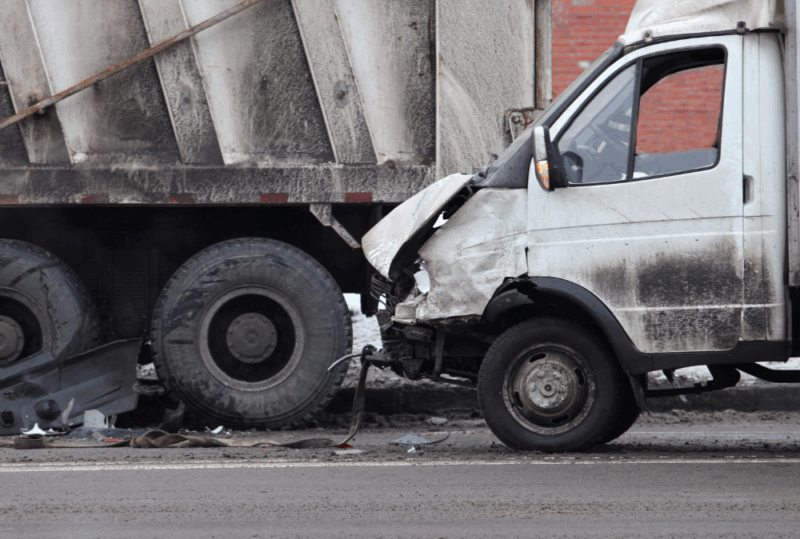Harlene Labrum | July 9, 2025 | Truck Accidents
The Dangers of Underride Accidents in Nashville: What You Need to Know

If you’ve ever driven alongside a large commercial truck, you probably understand how intimidating they can be. But what many drivers don’t realize is just how devastating an accident involving one of these trucks can be, especially underride accidents in Nashville.
While all collisions involving large commercial vehicles can be serious, this particular type of crash stands out for its sheer danger and often catastrophic outcomes.
If you or a loved one has been involved in one of these crashes, understanding your rights and options is critical. In this article, our Nashville truck accident lawyers will walk you through what underride accidents are, why they’re so dangerous, and how you can protect yourself and your family.
What is an Underride Accident?
An underride accident occurs when a passenger vehicle partially or completely slides underneath the rear or side of a commercial truck or trailer.
There are two main types:
- Rear Underride Crashes: These occur when a vehicle runs into the back of a truck and slides beneath the trailer.
- Side Underride Crashes: These happen when a vehicle collides with the side of a truck, often during lane changes, turns, or when a truck is crossing or entering a roadway.
These types of accidents typically happen in situations involving poor visibility, sudden stops, or when trucks lack proper safety guards.
Common Causes of Underride Accidents
Some of the most common causes of underride accidents in Nashville include:
- Sudden or Improper Braking: If a truck stops unexpectedly, a following vehicle may not have enough time to react, leading to a rear underride.
- Lack of or Poorly Maintained Underride Guards: Federal law requires trucks to have rear underride guards, but not all are properly installed or maintained. Side guards are not always present.
- Poor Visibility or Inadequate Truck Lighting: Dimly lit or poorly marked trailers are hard to see, especially at night or in bad weather.
- Speeding or Distracted Driving: Both truck drivers and other motorists can contribute to underride crashes through reckless or inattentive driving.
- Failure to Maintain a Safe Following Distance: Tailgating increases the risk of underride collisions if the lead vehicle stops suddenly.
Why Underride Accidents Are So Dangerous
Underride accidents are among the most deadly types of crashes for several reasons:
- Increased Risk of Decapitation or Catastrophic Injury: The height difference between trucks and passenger vehicles means the impact often bypasses standard safety features, causing severe head and neck injuries.
- Low Survival Rates: The force and nature of these crashes make fatal outcomes tragically common.
- Lack of Protection for Passengers: Airbags and crumple zones are less effective when a vehicle slides under a truck, exposing occupants to direct impact with the trailer.
- Delayed Medical Response: These accidents often occur on highways or rural roads, where emergency response may be slower, worsening injury outcomes.
Federal Safety Regulations and Guard Requirements
Fortunately, underride guards are required to be installed to prevent these types of tragedies. The Federal Motor Carrier Safety Administration (FMCSA) and the National Highway Traffic Safety Administration (NHTSA) have established rules requiring trucks to have rear underride guards.
The requirements include:
- Rear Guard Requirements: Trucks are required to have rear underride guards, sometimes called “Mansfield bars,” designed to prevent vehicles from sliding underneath in a rear-end collision. Recent rules also require these guards to be included in annual safety inspections.
- Side Guard Debate: There is currently no federal mandate for side underride guards, though safety advocates and some states are pushing for these life-saving devices.
- Enforcement Challenges: Even with existing rules, not all trucks are properly equipped or maintained. Compliance and enforcement remain ongoing issues.
Enforcement is another problem. Some companies cut corners by installing guards that don’t meet standards or failing to replace damaged ones. Regulatory agencies continue to push for stronger rules, but many believe the industry moves too slowly on this critical safety issue.
Liability in Underride Accidents
Determining liability in an underride accident can be complex. If you or a loved one has been involved in underride accidents in Nashville, several parties may be held liable for your injuries:
- Truck Driver: Negligence, such as distracted driving, improper braking, or failing to use hazard lights, can make the driver liable.
- Trucking Company: Companies may be at fault for failing to maintain vehicles, install required guards, or train drivers properly.
- Manufacturer or Maintenance Provider: If a defect or poor maintenance contributed to the accident, these parties could be held accountable.
- Shared Fault in Tennessee: Tennessee follows comparative negligence laws, meaning your compensation may be reduced if you are found partially at fault, but you can still recover damages if you are less than 50% responsible.
Tennessee follows a comparative negligence rule. This means that even if you’re found partially at fault for the accident, you may still recover compensation, as long as your share of fault is less than 50%.
Holding the right parties accountable requires a detailed investigation into how the accident occurred and what safety failures contributed to it.
What to Do After an Underride Crash
The immediate aftermath of any serious accident is chaotic, but knowing what steps to take can protect your rights and strengthen your potential legal claim:
- Call Emergency Services Immediately: Call 911 to report the accident, request medical assistance, and ensure law enforcement responds to create an official report.
- Document the Crash Scene and Damage: If it’s safe to do so, take as many photos and videos as possible of the vehicles involved, the underride guard (or lack thereof), the surrounding environment, road conditions, and any visible injuries.
- Request a Copy of the Police Report: The official police report will contain important details about the accident, including witness statements, initial assessments of fault, and details about the vehicles involved.
- Contact an Attorney Before Speaking to Insurance Adjusters: This is critical. Insurance adjusters, even those from your own company, work for the insurance company, not for you. Their goal is often to minimize payouts.
How a Truck Accident Lawyer Can Help
Underride accidents aren’t your typical fender-bender cases. They require an in-depth investigation and a firm understanding of trucking industry safety standards.
Here’s how a Nashville truck accident lawyer from Labrum Law can help you with your case:
- Investigating safety violations, including missing or defective underride guards and logbook violations by the truck driver.
- Securing expert testimony from accident reconstruction specialists and mechanical engineers.
- Calculating damages to cover your medical expenses, lost income, pain and suffering, or wrongful death claims.
- Taking on the insurance companies and trucking corporations, fighting for fair compensation when they try to avoid responsibility.

Underride Accidents in Nashville Are Preventable – Hold the Right Parties Accountable
Underride accidents are not just tragic; they are often preventable. The technology and regulations to significantly reduce these horrific crashes exist, and when they occur, it’s often due to negligence—whether it’s a truck driver, a trucking company, or a manufacturer failing to prioritize safety.
If you or a loved one has been a victim of an underride accident, please don’t hesitate to reach out. Call the highly-rated law offices of Labrum Law Firm in Nashville, TN, today at (615) 338-9500 or fill out our online contact form to schedule a free consultation.
